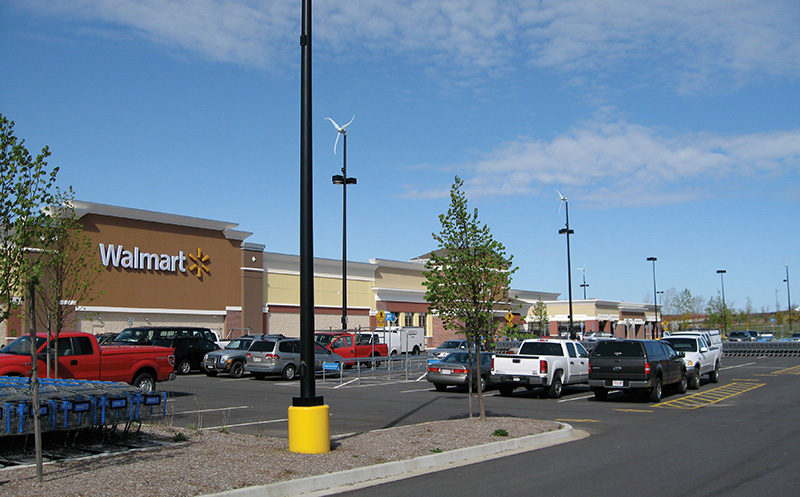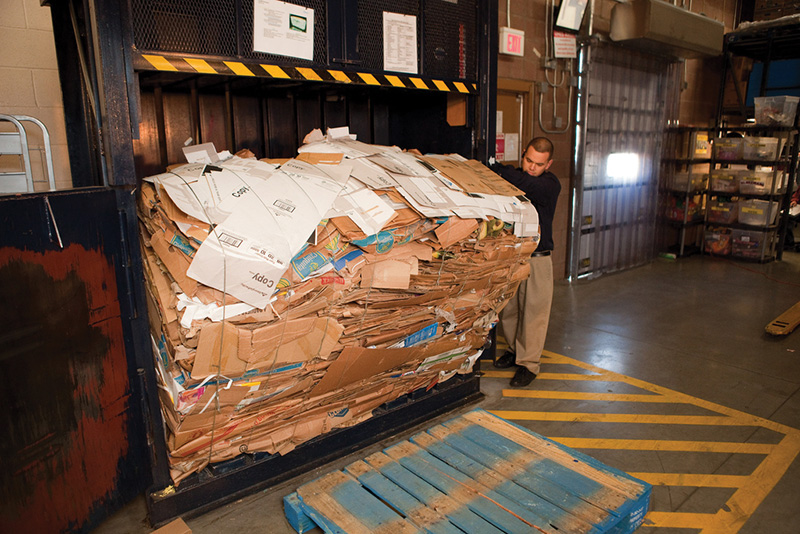Walmart embarks on a new era of “trust and transparency,” expanding on its 2005 environmental sustainability goals with ambitious new goals set for 2025.
Interview By Katie Lee
On November 4, 2016 at the Net Impact Conference in Philadelphia, Walmart’s president and CEO, Doug McMillon, unveiled a new road map for the future relating to the company’s environmental sustainability goals. He spoke of a “new era of trust and transparency” for Walmart, a company that pledges to do the right thing on a grand, global scale. Retail & Restaurant Facility Business recently interviewed Laura Phillips, Walmart’s senior vice president of sustainability, to learn more about the ambitious new goals.
R&R: Walmart’s 2020 Energy Efficiency Goal was to increase energy efficiency by 20% since 2010. Last year, internationally, you had reduced kWh-per-square-foot energy intensity by 10%. Where do things stand today?
 Laura Phillips: Looking back, in 2013, we made two specific commitments for renewable energy we aim to reach by 2020: (1) to drive the production or procurement of 7 billion kWh of renewable energy globally every year and (2) to accelerate efficiency by reducing the kWh/sq. ft. energy intensity required to power Walmart’s buildings globally by 20% compared to 2010 levels.
Laura Phillips: Looking back, in 2013, we made two specific commitments for renewable energy we aim to reach by 2020: (1) to drive the production or procurement of 7 billion kWh of renewable energy globally every year and (2) to accelerate efficiency by reducing the kWh/sq. ft. energy intensity required to power Walmart’s buildings globally by 20% compared to 2010 levels.
So far on our energy efficiency goal, we have reduced kWh-per-square-foot energy intensity by 10%, which represents a 1% absolute reduction since the end of 2014. We are on track to meet this goal — and will pursue our new goal compared to a 2015 baseline.
Now looking ahead to 2025, we’ve set new goals — science-based targets — to help us continue on this path. We are the first retailer with an emissions-reduction plan approved by the Science Based Targets Initiative, in alignment with the Paris Climate Agreement.
Under the recently approved plan, we will use a combination of energy-efficiency measures; together with a commitment to source half of our company’s energy needs from renewable sources, to reduce emissions our own operations by 18% by 2025. Additionally, we will work with suppliers to reduce emissions by 1 Gigaton by 2030, the equivalent of the total emissions of all passenger vehicles in the U.S. over an entire year.
R&R: What renewable energy sources is Walmart currently leveraging?
Phillips: We are investing in a number of renewable energy projects, including solar, wind, hydro and fuel cells.
R&R: Let’s talk about the “new era of trust and transparency” per CEO and President Doug McMillon, as presented at the Net Impact Conference in November 2016 in Philadelphia. Can you comment on Walmart’s efforts to (a) double the sales of locally grown produce in the U.S. by 2025 compared to 2016 levels?
Phillips: In the U.S., we believe “locally grown” refers to produce that is grown and sold in the same state. We believe there are many opportunities to help bring produce production closer to our customers and provide freshness with less food miles and also with less greenhouse gases, as a growing controlled environment can enable growth in many climates where previously it wasn’t possible.
R&R: (b) source half of the company’s energy needs from renewable resources to achieve 18% emissions reduction in its own operations by 2025?
 Phillips: By 2025, we aim to power half of our operations from renewable sources. We’ll accomplish this through continued investment in clean energy sources, including solar onsite and offsite, and wind power.
Phillips: By 2025, we aim to power half of our operations from renewable sources. We’ll accomplish this through continued investment in clean energy sources, including solar onsite and offsite, and wind power.
We are also the first retailer with an emissions-reduction plan approved by the Science Based Targets Initiative, in alignment with the Paris Climate Agreement. Under the recently approved plan, we will use a combination of energy-efficiency measures, together with expanded use of renewable energy, to reduce emissions our own operations by 18% by 2025.
R&R: (c) work with suppliers to reduce emissions by 1 Gigaton by 2030?
Phillips: Our goal to work with suppliers to reduce emissions by 1 Gigaton by 2030 is part of our emissions-reduction plan approved by the Science Based Targets Initiative. As always, we’ll continue to work alongside suppliers to encourage progress.
R&R: Please discuss the significance of Walmart’s approval by the Science Based Targets Initiative, in alignment with the Paris Climate Agreement in December 2015.
Phillips: This is a significant step for our industry. We recognize that the attainment of this goal will require the collective efforts of our suppliers, customers, associates and stakeholder partners.
The specific process we followed was based on what is referred to as a sectoral decarbonization approach (SDA). This process considers a company’s current performance, the unique opportunities and challenges of the industry sector in which they fit, and allocates reduction targets accordingly based on this information. You can read more about this process at http://sciencebasedtargets.org/methods/.
R&R: Explain how the new road map builds on the three environmental sustainability goals Walmart set in 2005: (a) to create zero waste in company operations; (b) to operate with 100% renewable energy; and (c) to sell products that sustain natural resources and the environment. These goals were set forth by former CEO Lee Scott, correct?
Phillips: Yes, they were set forth by former CEO Lee Scott in 2005. On our journey since then, we have deepened and broadened our aspirations to include not only specific sustainability goals, but we’ve also focused on opportunity for associates in our operations and within the retail sector and helping communities where we operate.
 Zero Waste
Zero Waste
Phillips: We know that the cycle of waste and materials is interconnected. We aim to break the link between our growth and waste by eliminating waste in our operations, and drive improvement upstream and downstream in our supply chain. We will pursue this goal by working with suppliers and customers in pursuit of a more circular economy.
In food specifically, we are going to expand our work on food waste to upstream at the farm, where we will maximize the value of food and reduce waste beginning in produce where we purchase direct from farmers.
We have also set a goal to have our private brand packaging be 100% recyclable by 2025.
In pursuit of our original aspiration to create zero waste, we will achieve zero waste to landfill in our own operations in the U.S., UK, Japan and Canada by 2025. The commitment is designed to meet or exceed EPA zero waste guidelines.
100% Renewable Energy
Phillips: Our new 2025 goals ladder up to our aspirational goal to supplied by 100 percent renewable energy, as they will help us get closer to that overarching aspiration.
As I mentioned earlier, by 2025, we aim to power half of our operations from renewable sources. We’ll accomplish this through continued investment in clean energy sources, including solar and wind power. Under our approved Science Based Targets Initiative plan, we will use a combination of energy efficiency measures, together with expanded use of renewable energy, to reduce emissions our own operations by 18% by 2025, as well as work with suppliers to reduce emissions by 1 Gigaton by 2030.
Products
Phillips: We are focused on improving packaging, providing affordable, healthier, safe food and products for customers, and advancing our work to preserve natural resources. One way we’re doing so is through our recently announced goal for all Walmart U.S. private brand products to use 100% recyclable packaging by 2025.
We also have a goal to become the most affordable, healthier food provider in the world. Customers trust us to provide healthier and affordable products to them and their families in a way that saves them time and money. To continue to earn that trust, we are focusing on sustainable sourcing, making healthier options easy and affordable, as well as product safety. When it comes to sustainable sourcing, by 2025 we’ll double the sales of locally grown produce in the U.S.
R&R: In 2015, 25% of Walmart’s operations were powered by renewable energy. What about 2016 and the anticipated percentage in 2017?
Phillips: At the end of 2015, we had more than 470 on-site and offsite projects in operation or under development in seven international countries and 17 U.S. states. Together with renewable electricity from the grid, 25% of our electricity needs globally were supplied by renewable sources at the end of 2015. Each year we report on the previous year’s progress through our annual Global Responsibility Report, so we’ll be sharing an update on 2016 next spring.
R&R: In 2015, 75% of Walmart’s global waste was diverted from landfills. Under the road map, the company will achieve zero waste to landfill from its own operations in the U.S., UK, Japan and Canada by 2025. The commitment is designed to meet or exceed EPA zero waste guidelines. Can you please elaborate on this plan?
Phillips: Shortly after former Walmart CEO Lee Scott announced zero waste as one of company’s three aspirational goals in 2005, Walmart U.S. set up a public goal to achieve zero waste to landfill by 2025. Now we are expanding this aspiration to three key markets: Canada, UK and Japan.
In order to achieve this goal we will work on reducing waste generation in the first place, donating and recycling products and materials that go unpurchased by customers. That will include:
• Optimizing forecasting and ordering, improving product packaging and enhancements in the process of food handling in our distribution centers, in transit and at store level in order to prevent food waste generation.
• Integrating reusable packaging in our global operations to reduce amount of cardboard and plastics materials generated from secondary packaging.
• Focusing on donation, composting, and animal feed and anaerobic digestion for unsold food.
• Establishing partnerships with food banks to capture food waste that is fit for human consumption and recycling organizations globally to process waste into alternative usable forms.
• Maximizing recycling of secondary packaging, used assets and other materials through reverse logistics. Facilitating closed loops when materials from the back of our store are used to produce new products that will be sold on our shelves.
• Supporting waste to energy technology innovations for residual material that cannot be recycled.
— This article originally appeared as the December 2016/January 2017 cover story of Retail & Restaurant Facility Business magazine. Email the editor at [email protected].
